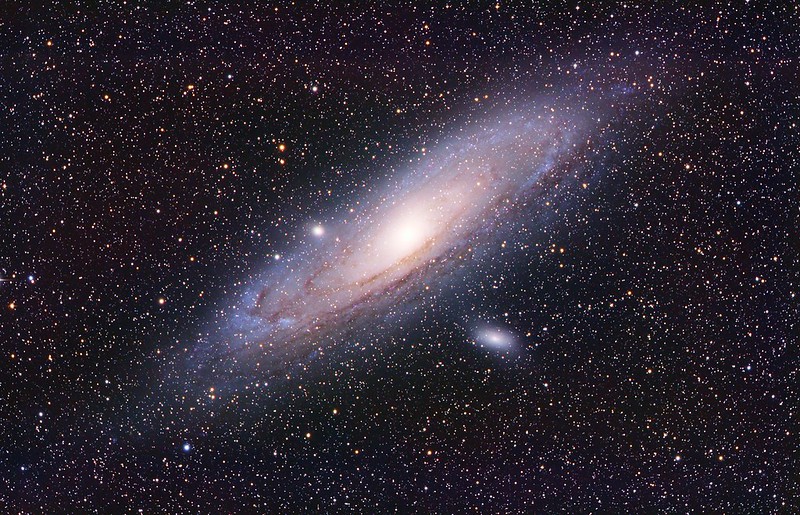
A century ago, on the night of October 5/6, 1923, Edwin Hubble’s photographic observations of a Cepheid variable settled the vexing question of the day: Our Milky Way is not the entire universe. | By Tim Lyster
Our modern-day description of the cosmos includes hundreds of billions of galaxies, of which the Milky Way is but one member, distributed across the vastness of space. But in the early 1900s, astronomers were divided over the universe’s size and true nature, and questioned whether the faint, unresolved smudges seen glowing in the night sky were relatively small gas clouds lying on the outskirts of the Milky Way, or enormous “island universes,” galaxies just like our own.
The Shapley-Curtis Debate
Enter the Great Debate of April 26, 1920. Hosted by the National Academy of Sciences at the Smithsonian Museum of Natural History, the public discussion pitted two Californian astronomers against one another. Harlow Shapley of the Mount Wilson Solar Observatory, and Heber D. Curtis of the Lick Observatory, both gave talks under the title "The Scale of the Universe.”
Shapley proposed that the so-called spiral nebulae—the “clam-shell-like luminous objects seen by great telescopes”—were merely clouds of gas, and that the Milky Way (which he proposed spanned 300,000 light-years) comprised the universe in its entirety—to believe otherwise would lead to unimaginable distances. Curtis defended the position that the Milky Way’s diameter measured 30,000 light-years and further contended that the Andromeda and other nebulae were separate galaxies.
By many accounts, Curtis, the more accomplished speaker, was viewed as the debate’s “winner.” But it would take an observation three years later by Edwin P. Hubble to settle the matter.
A Discovery that Changed Our View of the Universe
On the night of October 5-6, 1923, Hubble deployed the 100-inch Hooker reflector—at the time, the largest telescope in the world—to make photographic plates of Messier 31. Despite poor seeing, his 45-minute exposure was able to resolve individual stars. Later, by comparing one of the plates to an earlier set, he identified what he believed to be three novae, which he marked with an “N.”
Further investigation indicated that one of the ‘novae’ had changed brightness over a period far too short for a typical nova. By examining the star’s light curve, Hubble correctly surmised that he had discovered the first Cepheid variable in M31. He crossed out the “N” and replaced it with “VAR!”
The observations, when combined with Henrietta Leavitt’s period-luminosity law, led Hubble to conclude the star’s distance to be approximately 900,000 light-years (current estimates place it at 2.537 million light-years), far further than even the upper limits of the Milky Way’s diameter at the time. The conclusion was clear: the spiral nebulae were incredibly distant and could not possibly be within our own galaxy.
A Universe Destroyed
Upon receiving Hubble’s letter announcing his discovery, Shapley remarked “Here is the letter that has destroyed my universe." By the close of 1924, Hubble had identified 36 variables in M31, a third of which were Cepheids. Despite being proved wrong, Shapley encouraged Hubble to publish his findings, and the subsequent paper, “Extragalactic Nature of Spiral Nebulae,” appeared in a joint meeting of the American Astronomical Society and American Association for the Advancement of Science. It shared the prize for best paper.
A Hundred Years of Observations
October 6, then, marks the centennial of Hubble’s first observation of M31-V1, M31’s first Cepheid. Cepheid variables serve as a critical rung on the Cosmic Distance Ladder, and thus M31-V1 has remained an object of interest.
In 2010, the AAVSO launched a campaign to observe M31-V1, to support later observations by the Hubble Space Telescope (HST). Ten members made 214 observations of V1 from July to December 2010, capturing four pulsation cycles. The AAVSO study allowed the Hubble Heritage team to target HST observations that would image the star when at its brightest and dimmest.
The resulting paper, “Modern Observations of Hubble’s First-discovered Cepheid in M31,” confirmed the star’s periodicity as 31.4 (±0.1) days. The authors noted, “Continued observations in the modern era will be very valuable in linking these modern data with data from the 1920s–1930s and 1950s and will enable us to measure period change in this historic Cepheid. In particular, we strongly encourage intensive observations of this star around predicted times of maximum to constrain the date of maximum to better than 0.5 days.”
Into the Future
While the scale of the universe is now better understood, questions remain! Distances calculated by traditional means, like Cepheid variables, do not match those inferred from the cosmic microwave background. Whether the discrepancy is due to measurement errors or may indicate something more fundamental about our understanding of how the universe works, is yet unknown.
Thus, continuing to make ever-more precise observations of Cepheids—as the James Webb Space Telescope is doing—remains of critical importance to the astronomical community.
It begs the question, what further exciting discoveries await astronomers as our knowledge of variable stars continues to grow? ![]()
Endnote
The 'Great Debate': What Really Happened, by Michael A. Hoskin
Image: Kees Scherer (Flickr)

